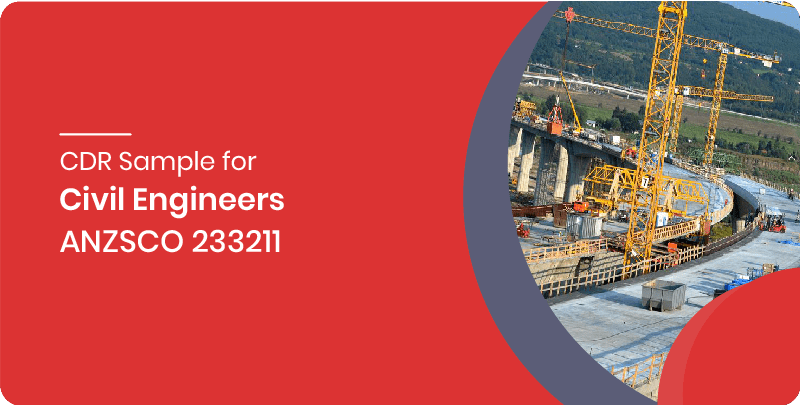CDR Sample for Civil Engineers 233211
Having Trouble Writing your CDR Report ?
Get in Touch with Our Writers to get the Help you Need and Avoid Possible Rejection!
Or talk to our writers at +61 481 614 316 / +61 483 968 416
Civil Engineering: ANZSCO 233211
Civil engineers make, improve, and secure the nature in which we live. They plan, plan, and direct development and upkeep of building structures and framework, such as streets, railroads, air terminals, spans, harbors, dams, water system ventures, power plants, and water sewerage frameworks.

Competency Demonstration Report (CDR) Sample for Civil Engineers
The Competency Demonstration Report Sample for Civil Engineer includes all the necessary reports such as Three Career Episodes, Continuing Professional Development, Summary Statement and Curriculum Vitae. The Content of the Sample is as follow
Civil Engineer Career Episode Report Samples
The career episode must be written on your own based on your recent work experience and must be in the English language. Each career episode should highlight the problems faced in your project and the steps taken to overcome them. It would be best if you numbered each paragraph of your career episodes as “ Career episode 1 (paragraphs 1.1, 1.2, 1.3, etc.) “. The primary four components are as follows:
Project Name: Studies of Glass Fiber Reinforced Concrete Composites
In first Career Episode, the author discusses the project he carried out when he was a final year student of International Journal of Structural and Civil Engineering and the project was titled “Studies of Glass Fiber Reinforced Concrete Composites”. In this project, his role were:
To outline the experimental investigation conducted on the use of glass fibers with structural concrete
To study the properties of Fiber Reinforced Concrete (FRC)
To perform an experiment using Portland pozzolona cement of 43 Grade
To overcome the incapacity of concrete in tension and the ductility magnitude of compressive strength
TTo prepare the detailed table based on the mixing procedure and show the relationship between increase in compressive and fiber strength for different fiber content
Project Name:Monitoring of Civil Engineering Structures using Digital Image Correlation Technique
In the second Career Episode, the author writes in detail about the project entitled “Monitoring of Civil Engineering Structures using Digital Image Correlation Technique”. He performed this project when he was working at Warsaw Institute of Technology. Some of the important tasks he did on this project are listed as follows:
Present an adaptation of DIC technique for monitoring of civil-engineering structures.
Avail additional connections and extensions to facilitate the measurements and improve the efficiency of data analysis
Introduction of new software features that facilitate outdoor measurements.
Develop a monitoring system within the MONIT project and use the modified DIC sensors at different accuracy levels
Preparing work plans, quantity estimates, and reports.
Project Name:Reduction of Downhole Friction by Electrochemical Methods
In third Career Episode, the author explains the project he was involved in for the Degree of Philosophy. The project name was “Reduction of Downhole Friction by Electrochemical Methods”. The key responsibility of the writer were:
To design a tribometer which incorporates a three electrode electrochemical cell to allow study in the area of tribochemistry
To access the concept of reducing the friction by applying the potentials. This includes the contacts between steel/steel and steel/sandstone which are stimulating the drilling conditions.
To experiment with different friction modifying additives to aid the understanding of the friction reduction concept
To characterize the adsorption of the additive, and use this method to aid the analysis of the friction and wear results
TTo relate between the electrochemical test results in breaker with the recorded results during the sliding tests. This would increase the understanding of the mechanism of the additives in producing a tribofilm which is useful in low friction and wear.
Pricing of Complete CDR Writing
We provide Complete CDR writing service on the basis of your urgency level and prices respectively. There are currently three varients of service that you can purchase which are shown below.
15 days plan
$
799
AUD
10 days plan
$
999
AUD
7 days plan
$
1299
AUD
1000s of Satisfied Customers
Our Services receive great response and guarantee Success. Few client feedbacks are shown below.
Our Hundreds of Clients are getting Successful Approval, When will you?
Our primary goal is to ensure our clients' successful approval through well-documented CDR reports that match EA standards for migrants. CDR Writers Australia provides quality CDR and ACS skill assessment services, aiming for 100% skill assessment success.

Best Prices

On-time Delivery

Report Structure

100% Original Content
Feeling Curious? Get Your CDR Approved—Call Us Now! +61 481 614 316 / +61 483 968 416
We are here to answer all your queries and provide you the best service. Feel free to contact our writers for your concerns.

